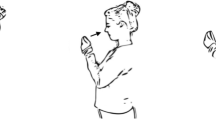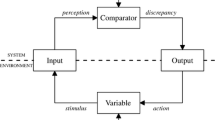Abstract
Approach motivation is the energization of behavior by, or the direction of behavior toward, positive stimuli (objects, events, possibilities), whereas avoidance motivation is the energization of behavior by, or the direction of behavior away from, negative stimuli (objects, events, possibilities). In this article, I provide a brief overview of this distinction between approach and avoidance motivation. In addition, I provide a brief overview of a model of motivation in which this approach-avoidance distinction plays an integral role—the hierarchical model of approach-avoidance motivation.
Similar content being viewed by others
References
Allport, G. W. (1937). Personality: A psychological interpretation. NY: Holt.
Arnold, M. (1960). Emotion and personality. NY: Columbia University Press.
Atkinson, J. W., & Birch, D. (1970). The dynamics of action. NY: Wiley.
Bargh, J. A. (1997). The automaticity of everyday life. Advances in Social Cognition, 20–27.
Bargh, J. A., & Ferguson, M. J. (2000). Beyond behaviorism: On the automaticity of higher mental processes. Psychological Bulletin, 126, 925–945.
Bentham, J. (1779/1879). Introduction to the principles of morals and legislation. Oxford: Clarendon Press.
Berridge, K. (1999). Pleasure, pain, desire, and dread: Hidden core processes of emotion. In D. Kahneman, E. Diener, & N. Schwarz (Eds.). Wellbeing: The foundations of hedonic psychology (pp. 525–557). New York: Russell Sage Foundation.
Cacioppo, J., & Bernston, G. (1994). Relationship between attitudes and evaluative space: A critical review, with emphasis on the separability of positive and negative substrates. Psychological Bulletin, 115, 401–422.
Carver, C., & Scheier, M. (1998). On the self-regulation of behavior. NY: Cambridge University Press.
Corwin, G. (1921). Minor studies from the psychological laboratory of Cornell University. American Journal of Psychology, 32, 563–570.
Cury, F., Elliot, A. J., Da Fonseca, D., & Moller, A. (in press). The social-cognitive model of achievement motivation and the 2 × 2 achievement goal framework. Journal of Personality and Social Psychology, 90, 666–679.
Davidson, R. J. (1993). Parsing affective space: Perspectives from neuropsychology and psychophysiology. Neuropsychology, 7, 464–475.
Elliot, A. J. (1997). Integrating “classic” and “contemporary” approaches to achievement motivation: A hierarchical model of approach and avoidance achievement motivation. In P. Pintrich & M. Maehr (Eds.), Advances in motivation and achievement (vol. 10, pp. 143–179). Greenwich, CT: JAI Press.
Elliot, A. J. (1999). Approach and avoidance motivation and achievement goals. Educational Psychologist, 34, 149–169.
Elliot, A. J., & Church, M. A. (1997). A hierarchical model of approach and avoidance achievement motivation. Journal of Personality and Social Psychology, 72, 218–232.
Elliot, A. J., & Covington, M. V. (2001). Approach and avoidance motivation. Educational Psychology Review, 13, 73–92.
Elliot, A. J., & Fryer, J. W. (in press). The goal concept in psychology. In J. Shah & W. Gardner (Eds.), Handbook of motivational science (pp. xxx–xxx). NY: Guilford Press.
Elliot, A. J., Gable, S. L., & Mapes, R. R. (2006). Approach and avoidance motivation in the social domain. Personality and Social Psychology Bulletin, 32, 378–391.
Elliot, A. J., & Harackiewicz, J. M. (1996). Approach and avoidance achievement goals and intrinsic motivation: A mediational analysis. Journal of Personality and Social Psychology, 70, 461–475.
Elliot, A. J., & Mapes, R. R. (2005). Approach-avoidance motivation and self-concept evaluation. In A. Tesser, J. Wood, & D. Stapel (Eds.), On building, defending, and regulating the self: A psychological perspective (pp. 171–196). Washington, D.C.: Psychological Press.
Elliot, A. J., McGregor, H. A., & Thrash, T. M. (2002). The need for competence. In E. Deci & R. Ryan (Eds.), Handbook of Self-determination Research (pp. 361–387). Rochester, NY: University of Rochester Press.
Elliot, A. J., & Reis, H. T. (2003). Attachment and exploration in adulthood. Journal of Personality and Social Psychology, 85, 317–331.
Elliot, A. J., & Sheldon, K. M. (1997). Avoidance achievement motivation: A personal goals analysis. Journal of Personality and Social Psychology, 73, 171–185.
Elliot, A. J., & Sheldon, K. M. (1998). Avoidance personal goals and the personality-illness relationship. Journal of Personality and Social Psychology, 75, 1282–1299.
Elliot, A. J., & Thrash, T. M. (2001). Achievement goals and the hierarchical model of chievement motivation. Educational Psychology Review, 12, 139–156.
Elliot, A. J., & Thrash, T. M. (2002). Approach-avoidance motivation in personality: Approach and avoidance temperaments and goals. Journal of Personality and Social Psychology, 82, 804–818.
Elliot, A. J., & Thrash, T. M. (2004). The intergenerational transmission of fear of failure. Personality and Social Psychology Bulletin, 30, 957–971.
Freud, S. (1915). Repression. In the standard edition of Complete Psychological Works of Sigmund Freud, vol. XIV. London: Hogarth, 1957.
Herzberg, F. (1966). Work and the nature of man. Cleveland, OH: Ward.
Higgins, E. T. (1997). Beyond pleasure and pain. American Psychologist, 52, 1280–1300.
Hopkin, D. V. (1995). Human factors in air traffic control. NY: CRC Press.
James, W. (1890). The principles of psychology (vol. 2). NY: Henry Holt & Co.
Lang, P. (1995). Studies of motivation and attention. American Psychologist, 50, 372–385.
LeDoux, J. (1995). Emotion: Clues from the brain. Annual Review of Psychology, 46, 209–235.
Lewin, K. (1935). A dynamic theory of personality. NY: McGraw-Hill.
McClelland, D. C. (1985). Human Motivation. NY: Cambridge University Press.
McDougal, W. (1908). An introduction to social psychology. Boston: John W. Luce and Co.
Mowrer, O. (1960). Learning theory and behavior. NY: Wiley.
Murray, H. (1938). Explorations in personality. NY: Oxford University Press.
Osgood, C., Suci, G., & Tannenbaum, P. (1957). The measurement of meaning. Urbana
Schneirla, T. (1959). An evolutionary and developmental theory of biphasic processes underlying approach and withdrawal. In Nebraska Symposium on Motivation (pp. 1–42). Lincoln: University of Nebraska Press.
Sherington, C. A. (1906). The integrative actions of the nervous system. NY: Scribner’s.
Shizgal, P. (1999). On the neural computation of utility: Implications from studies of brain stimulation and reward. In D. Kahneman, E. Diener, & N. Schwarz (Eds.), Well-being: The foundations of hedonic psychology (pp. 500–524). NY: Russell Sage Foundation.
Stellar, J. R., & Stellar, E. (1985). The neurobiology of motivation and reward. NY: Springer-Verlag.
Thrash, T. M., & Elliot, A. J. (2001). Delimiting and integrating the goal and motive constructs in achievement motivation. In A. Efklides, J. Kuhl, & R. Sorrentino (Eds.), Trends and prospects in motivation research (pp. 3–21). Amsterdam: Kluwer Academic Publishers.
Tooby, J., & Cosmides, L. (1990). The past explains the present: Emotional adaptions and the structure of ancestral environments. Ethology and sociobiology, 11, 375–424.
Acknowledgements
Preparation of this article was supported by grant #2565 from the William T. Grant Foundation. Thanks to Ista Zahn for his helpful comments on an earlier version of this article.
Author information
Authors and Affiliations
Corresponding author
Rights and permissions
About this article
Cite this article
Elliot, A.J. The Hierarchical Model of Approach-Avoidance Motivation. Motiv Emot 30, 111–116 (2006). https://doi.org/10.1007/s11031-006-9028-7
Published:
Issue Date:
DOI: https://doi.org/10.1007/s11031-006-9028-7




